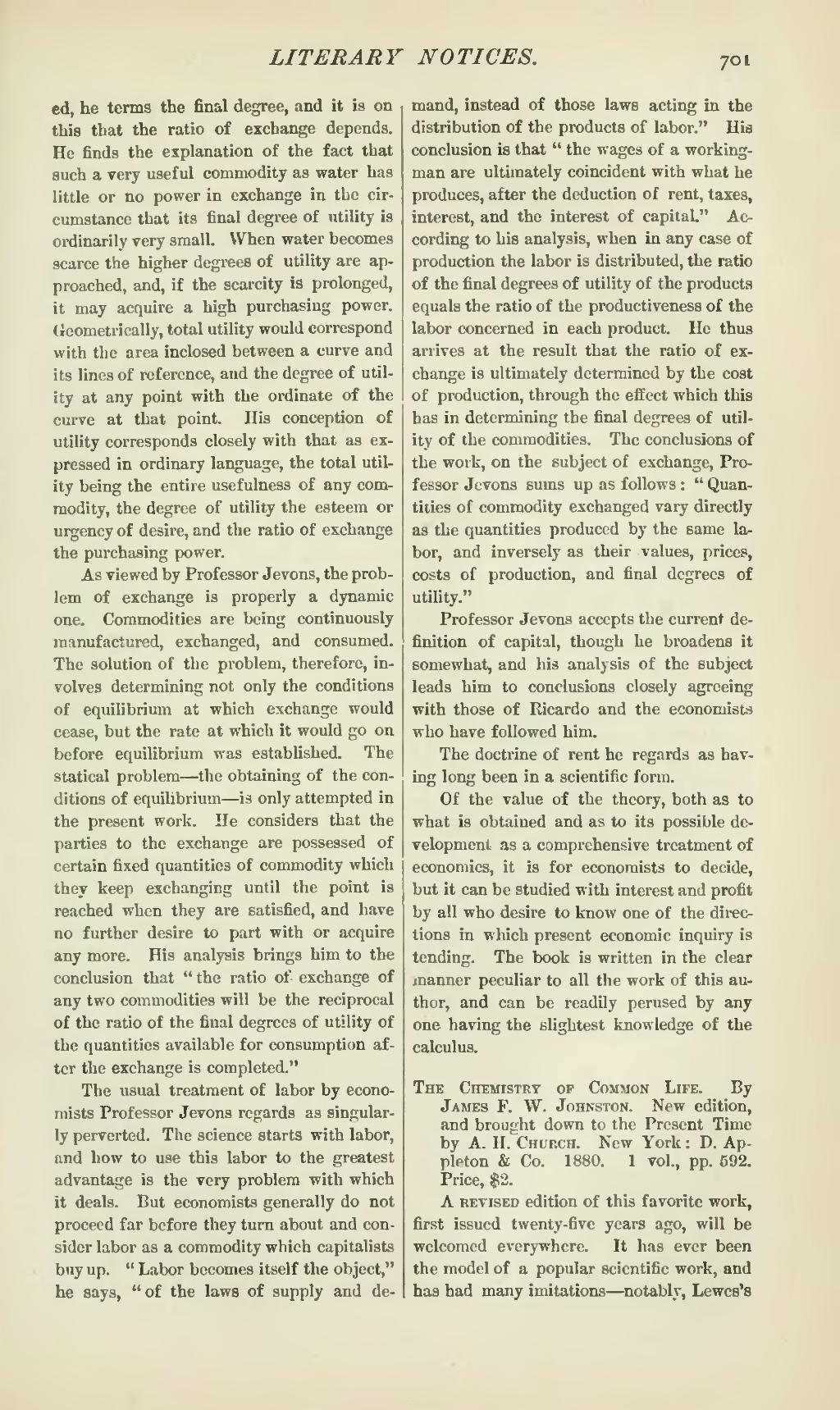ed, he terms the final degree, and it is on this that the ratio of exchange depends. He finds the explanation of the fact that such a very useful commodity as water has little or no power in exchange in the circumstance that its final degree of utility is ordinarily very small. When water becomes scarce the higher degrees of utility are approached, and, if the scarcity is prolonged, it may acquire a high purchasing power. Geometrically, total utility would correspond with the area inclosed between a curve and its lines of reference, and the degree of utility at any point with the ordinate of the curve at that point. His conception of utility corresponds closely with that as expressed in ordinary language, the total utility being the entire usefulness of any commodity, the degree of utility the esteem or urgency of desire, and the ratio of exchange the purchasing power.
As viewed by Professor Jevons, the problem of exchange is properly a dynamic one. Commodities are being continuously manufactured, exchanged, and consumed. The solution of the problem, therefore, involves determining not only the conditions of equilibrium at which exchange would cease, but the rate at which it would go on before equilibrium was established. The statical problem—the obtaining of the conditions of equilibrium—is only attempted in the present work. He considers that the parties to the exchange are possessed of certain fixed quantities of commodity which they keep exchanging until the point is reached when they are satisfied, and have no further desire to part with or acquire any more. His analysis brings him to the conclusion that "the ratio of-exchange of any two commodities will be the reciprocal of the ratio of the final degrees of utility of the quantities available for consumption after the exchange is completed."
The usual treatment of labor by economists Professor Jevons regards as singularly perverted. The science starts with labor, and how to use this labor to the greatest advantage is the very problem with which it deals. But economists generally do not proceed far before they turn about and consider labor as a commodity which capitalists buy up. "Labor becomes itself the object," he says, "of the laws of supply and demand, instead of those laws acting in the distribution of the products of labor." His conclusion is that "the wages of a workingman are ultimately coincident with what he produces, after the deduction of rent, taxes, interest, and the interest of capital." According to his analysis, when in any case of production the labor is distributed, the ratio of the final degrees of utility of the products equals the ratio of the productiveness of the labor concerned in each product. He thus arrives at the result that the ratio of exchange is ultimately determined by the cost of production, through the effect which this has in determining the final degrees of utility of the commodities. The conclusions of the work, on the subject of exchange, Professor Jevons sums up as follows: "Quantities of commodity exchanged vary directly as the quantities produced by the same labor, and inversely as their values, prices, costs of production, and final degrees of utility."
Professor Jevons accepts the current definition of capital, though he broadens it somewhat, and his analysis of the subject leads him to conclusions closely agreeing with those of Ricardo and the economists who have followed him.
The doctrine of rent he regards as having long been in a scientific form.
Of the value of the theory, both as to what is obtained and as to its possible development as a comprehensive treatment of economics, it is for economists to decide, but it can be studied with interest and profit by all who desire to know one of the directions in which present economic inquiry is tending. The book is written in the clear manner peculiar to all the work of this author, and can be readily perused by any one having the slightest knowledge of the calculus.
The Chemistry of Common Life. By James F. W. Johnston. New edition, and brought down to the Present Time by A. H. Church. New York: D. Appleton & Co. 1880. 1 vol., pp. 592. Price, $2.
A revised edition of this favorite work, first issued twenty-five years ago, will be welcomed everywhere. It has ever been the model of a popular scientific work, and has had many imitations—notably, Lewes's
